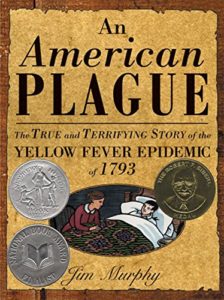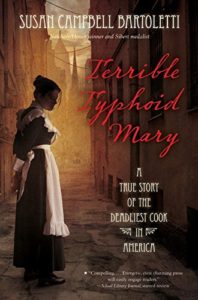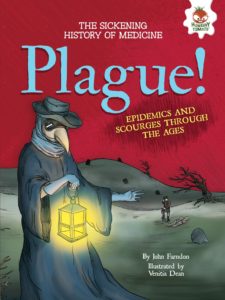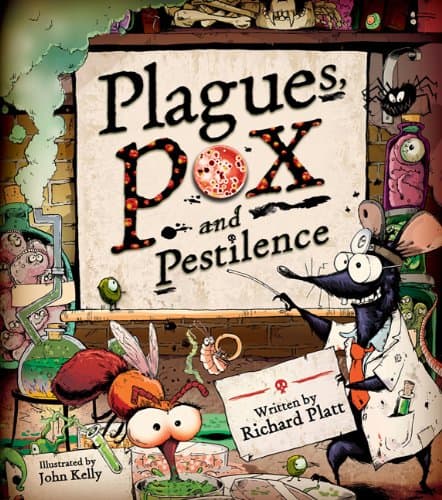Plagues, Pox, and Pestilence
By Richard Platt , Illustrated by John Kelly
Plagues, Pox, and Pestilence is a history of disease, and pestilence, told from the point of view of the bugs and pests that cause them. This book features case histories of epidemics and eyewitness accounts from the rats, flies, ticks and creepy-crawlies who spread diseases. There are lots of fascinating facts and figures on the biggest and worst afflictions. 7-12 years

Outbreak! Plagues That Changed History
By Bryn Barnard
Filled with fascinating, often gory details about disease and history, Outbreak! is the combination of science and history.
Did the Black Death destroy medieval Europe? Did cholera pave the way for modern Manhattan? Did yellow fever help end the slave trade? Remarkably, the answer to all of these questions is yes. Time and again, diseases have impacted the course of human history in surprisingly powerful ways. Bryn Barnard describes the symptoms and paths of the world’s worst diseases—and how the epidemics they spawned have changed history forever. 8-12 years

Epidemic, Pandemic, Should I Call the Medic?
By Baby Professor
What is the difference between epidemics and pandemics? Learn the difference and more in this biology book for kids. 6 and up

An American Plague:
The True and Terrifying Story of the Yellow Fever Epidemic of 1793
By Jim Murphy
In 1793, Philadelphia was the nation’s capital and the largest city in North America. It’s devastated by an apparently incurable disease, its cause unknown.
Jim Murphy describes the illness known as yellow fever. It took a toll on the city’s residents. He relates the epidemic to the major social and political events of the day and to 18th-century medical beliefs and practices. Drawing on first-hand accounts, he spotlights the heroic role of Philadelphia’s free blacks in combating the epidemic. And the Constitutional crisis that President Washington faced when he was forced to leave the city while escaping the deadly contagion. The search for the fever’s causes and cure, not found for more than a century afterward, provides a suspenseful counterpoint to this story of a city under siege. 10-12 years

Terrible Typhoid Mary: A True Story of the Deadliest Cook in America
By Susan Campbell Bartoletti
What happens when a person’s reputation has been forever damaged? With archival photographs and text among other primary sources, this biography of Mary Mallon looks beyond the tabloid scandal of Mary’s controversial life. How she was treated by medical and legal officials reveals a lesser-known story of human and constitutional rights. It’s entangled with the science of pathology and the enduring questions about who Mary Mallon really was. How did her name become synonymous with deadly disease? And who is really responsible for the lasting legacy of Typhoid Mary? This exploration includes an author’s note, timeline, annotated source notes, and bibliography. 12 and up

Plague! Epidemics, and Scourges Through the Ages
By John Farndon, Illustrated by Venitia Dean
Being sick is horrible. But it used to be worse. Inside this book, you’ll see evidence of the plagues of the past―rotting skin, dissolving lungs, and sinister swelling all over the body. Diseases like the Black Death wiped out whole towns and villages. Tuberculosis consumed young people like a bloodsucking vampire. And Smallpox left its victims scarred for life―if they survived. At the time, no one knew where these killer diseases came from or how to treat them. But eventually doctors discovered how these diseases and others were spread. Being sick isn’t quite as sickening as it was in the past! 8-12 years

Purple Death
By David Getz
The Spanish Flu was one of the worst epidemics in this country’s history, and the search for its cause is still one of science’s most urgent quests. David Getz tells young readers the story of the mysterious flu known as the Purple Death―the virus responsible for the worst epidemic in American history.
It was 1918, the last year of World War I. Thousands of men lived in crowded army training camps that were scattered all across the United States. That spring, a strange flu struck the soldiers at a camp in the Midwest. Healthy young men went to the hospital complaining of sore throats and fevers. Within hours they had suffocated, their skin taking on a terrible purplish hue.
The devastating flu spread like wildfire across the country, infecting soldiers and civilians alike. It killed more than half a million people in a matter of months, then disappeared as suddenly as it had come.
To this day, no one knows what caused a common flu to become so deadly, but scientists are still searching for answers. What they discover could save millions of lives if another common flu virus suddenly turns into a killer. 7-10 years

